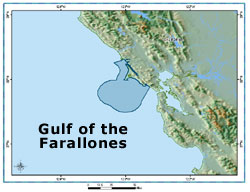|
 Public Warned Not to “Rescue” Seal Pups Public Warned Not to “Rescue” Seal Pups
Early last spring, sanctuary staff called on the public to not interfere with presumed, orphaned harbor seal pups on Bay Area beaches. Harbor seal mothers routinely leave pups on the beach while foraging, and the pups are sometimes mistaken as abandoned by beachgoers. The mother will not reclaim her pup while humans are present, so for people, remaining out of sight and notifying rangers or other officials is advised. A well-intentioned rescue could prevent a pup from being reunited with its mother, sometimes with fatal results.
One-fifth of California’s harbor seals breed within the Gulf of the Farallones National Marine Sanctuary. The sanctuary’s proximity to an urban center of nearly eight million people sometimes poses delicate problems regarding human-wildlife interaction. Seals are protected by the Marine Mammal Protection Act from unauthorized interference. The Sanctuary Education, Awareness and Long-term Stewardship Program, established to reduce human impact on harbor seals, recruits volunteers to give informal talks about seal natural history and to look through spotting-scopes to check wildlife disturbances, especially during breeding season. The program continually promotes public appreciation of these living resources.
Sanctuary Scientists Investigate Seabird Deaths
This spring, Beach Watch monitors discovered abnormally high numbers of common murre carcasses. Seabird die-offs are usually seen in late summer rather than in spring. Birds were moderately to severely emaciated, indicating a lack of food. At several major seabird colonies, many birds established then abandoned their nests. Analysis showed that unusual springtime conditions, including warmer sea temperatures and sustained strong winds, suppressed the customary upwelling that stimulates productivity throughout the ocean food web. It resulted in a population shift of krill, an important food, away from seabird breeding habitats. Most birds died or failed to breed due to starvation.
Sharkmobile Bites Hundreds with Shark Natural History
Sharks were the focus for hundreds of students from San Francisco Bay Area schools with the Sharkmobile, an education and outreach program of the Farallones marine sanctuary. Most students were surprised to learn that sharks play a vital role in the health of the marine ecosystem, eat a variety of food, and are not really “man-eaters” as often portrayed in the media. The Sharkmobile is a classroom program designed for fourth through sixth grade students on the biology, natural history and conservation of sharks.
California Ocean Forum A Hit With Bay Area Residents
Nearly 500 people attended the Forum on California’s Ocean Future in San Francisco. Keynote speaker Leon Panetta and panelists participated in a far-ranging discussion of current efforts to manage and protect California ocean resources, and examined what is needed to ensure their long-term health. The event forged a partnership between the sanctuary and the State of California to become leaders in California ocean protection.
Exclusive Stories for the Web
Research and Monitoring Cruise
In April, sanctuary staff completed a cruise to investigate how oceanographic features such as depth and current, and the distribution and abundance of marine organisms are linked. This study produced information on physical oceanography and upwelling dynamics in the Gulf of the Farallones and Cordell Bank areas, and confirmed previously obtained side-scan sonar images of the sea floor. The cruise collected data essential to future management decisions and also developed strong interagency collaborations for future ecological and mapping efforts. The cruise was a joint expedition with scientists from the U.S. Geological Survey and Point Reyes Bird Observatory Conservation Science.
Rocky Intertidal Monitoring Program at the Farallon Islands
The Farallones sanctuary released its annual report of its research project, begun in 1993, to monitor marine algae and invertebrates at the Farallon Islands off San Francisco. This provides a baseline of information in the event of an oil spill, vessel grounding or other catastrophic event, and links the Farallon Islands to mainland rocky intertidal sites along the West Coast, from Mexico to Canada. Over 500 species of invertebrates and algae have been documented at the Farallones, with four invertebrate species added to the list last year. The sanctuary, in collaboration with the Partnership for Interdisciplinary Studies of Coastal Oceans (PISCO), established a long-term site at Southeast Farallon and two mainland sites, including one to measure chronic impacts from the vessel Christopher M grounding.
Sandy Beach Monitoring Project
Students from 24 San Francisco Bay Area high schools and organizations participated in a monitoring project that took them into the world of data collection techniques to monitor sandy beach habitats. They captured mole crabs to record their size, reproductive status and infestation by thorny-headed worms for which these crabs are intermediate hosts. Roughly half the mortalities among the threatened California sea otter are caused by disease linked to the worms. In 1995, the worms caused a die-off of several thousand surf scoters, a coastal seabird.
 Plans for 2006 Plans for 2006
The sanctuary’s 25th anniversary will be celebrated with special events and programs, including the release of its draft management plan for public comment. The site will also unveil its facilities master plan, launch a California Ocean Stewardship Campaign to bring ocean discovery to all California schools, and install a major exhibit at San Francisco’s world-famous Aquarium of the Bay. Staff will also implement a seabird colony protection program, a first-of-its-kind comprehensive effort to protect seabirds at major rookeries along the northern and central California coast. It will also integrate its data into the sanctuary’s integrated monitoring network to allow users to access actual data and build downloadable maps of monitoring results.
|



